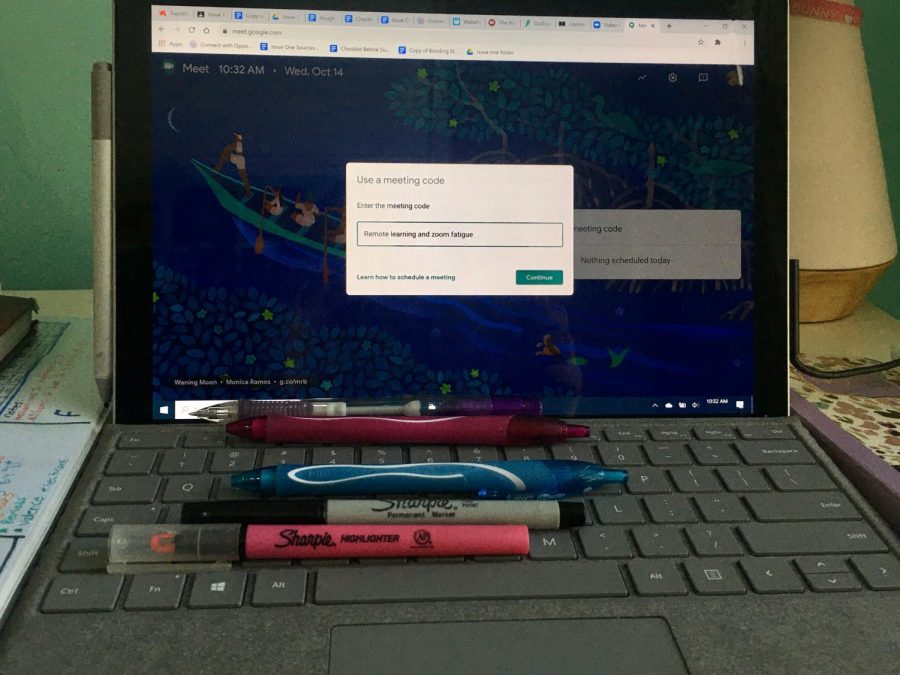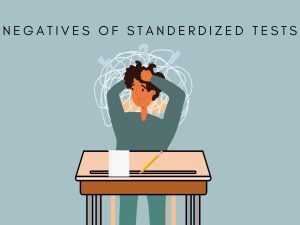How remote learning is impacting students and staff
Zoom is open on a laptop that is surrounded by school supplies.
October 30, 2020
Many parents, students and staff members have concerns about remote learning following the WCPSS board decision on September 29th. The board decision includes having grades K-8 return to in-person instruction on a three-week rotation schedule while having grades 9-12 stay remote until at least the end of first semester. Among the worries of parents, students and staff, are the health risks of being in front of a screen for at least seven hours a day.
Miranda Pikaart, a history and psychology teacher, has noticed a lot of negative impacts on her health and the health of her students.
“Headaches are going around like candy and it’s awful,” Pikaart said. “Migraines are coming back [along with] panic attacks and high levels of anxiety.”
Pikaart is not the only person at Wakefield with concerns. Senior Zeiad Yakout also has worries about how remote learning is affecting his health.
“Sometimes [I will have issues with] my vision,” Yakout said, “ [It will be] blurry for a few seconds and I assume it’s because of the extended screen time.”
However, these are not the only issues students and staff have. Amelia Miano, an English teacher, has concerns about students developing healthy relationships. It becomes very difficult for students to have a regular, functioning relationship with someone when they never see each other.
“There’s that human element that people need to have,” Miano said. “We are designed to have relationships with real people, not computer screens.”
Miano also has concerns about how well students are learning. With WCPSS not making it mandatory to have cameras on, it has become very difficult for teachers to see the physical indications that a student may be struggling. She has to rely on students telling her that they’re confused or lost.
“As a teacher of 27 years, [body cues and facial expressions] are the main thing I rely on to see if a student is struggling,” Miano said.
Teachers are not the only people noticing social differences either. Junior Madeline Policastro has also noticed it.
“It’s been very strange not being able to hang out with people during lunch or pride time,” Policastro said, “It has been very challenging to keep up my social life.”
Policastro also has some complaints regarding her health because of remote learning. Like many other students, she has noticed increased stress levels and frequent headaches.
“I have a bit of trouble staying focused,” Policastro said. “I work from seven am to around 10 pm every day. It’s becoming very tiring and I get headaches during the day.”
However, Policastri is also able to look at the bright side of things.
“I’ve found that I’ve had to develop a stronger work ethic,” Policastro said, “which is a positive thing that will come in handy in the future.”
Policastro isn’t the only student who sees the positive side of remote learning. Freshman Tessa Elmore also thinks that some good has come out of it.
“I like remote learning because my learning space is a bit quieter than a room full of [noisy] kids,” Elmore said.
Many people believe that going back to school will fix the problems caused by remote learning. However, going back to school will not mean going back to normal. Many things will be different.
“If we were back in the classroom,” Pikaart said, “I think we would have to be realistic about what that would look like.”
Masks, hand sanitizer, and social distancing aren’t the only preventative measures that WCPSS will put in place. There will be no communal supplies (this includes laptops), no group work, no eating lunch in groups, no Pride Time –just to name a few. These restrictions are not here to scare us though, they are simply here to protect us from COVID-19.
“Unfortunately I think we are going to be in some form of COVID-19 influenced academic environment for a very long time,” Pikaart said. “I think we need to be realistic with ourselves and know that when we go back, it’s not going to be the same, and it won’t be for a while.”












